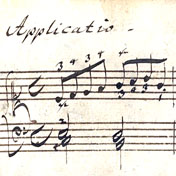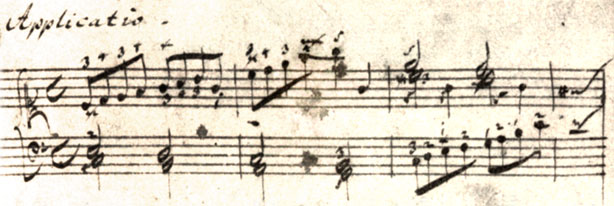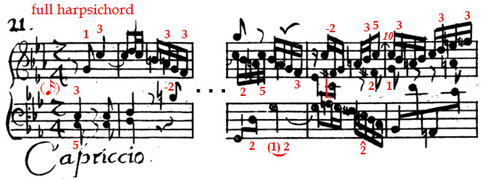Excerpts from this book:
Autograph—dated 1720—of the Applicatio in the Clavier-Büchlein vor Wilhelm
Friedemann Bach. It includes J.S. Bach's handwritten fingerings for ascending scales: right hand 3-4-3-4 … , left hand 2-1-2-1 … .FINGERING AND BACH
The goal of performing on historical instruments is to try to play an early music score with the overall sound, articulation, ornamentation and other subtleties the composer had in mind. To achieve this, the present consensus amongst professional performers of period instruments is that they should be played with a period technique. ...
It is unfortunate that—except for a few modern harpsichord methods with selected pieces from different composers—until very recently (when the author's edition of François Couperin's Pièces de Clavecin, Fingered with Baroque Technique, Vol. I was published in April 2015) no modern edition of Baroque keyboard music included Baroque fingerings. This does not make matters easy for early-keyboard players who wish to perform J.S. Bach and other Baroque composers with a period technique. ...
Hopefully, the author's Baroque fingering method—based on collating the historical sources—and now the present fully-Baroque-fingered edition of the keyboard Partitas, will help both students and professional harpsichordists to achieve the stylish rendering that J.S. Bach's keyboard masterpieces deserve.
EDITORIAL PROCESS
The original edition prepared under the personal supervision of J.S. Bach is now available from the internet as a digital facsimile. It was decided to use this source for the present fingered edition because (a) it is eminently readable, (b) it is in the Public Domain i.e. free from copyright and (c) it is free from Romantic additions found in many later editions ...
Although playing from the original composer's edition is both moving and exhilarating, some players will find that—inevitably—Bach's primitively engraved score does not make for an easy reading, and will prefer to play from a modern edition. For this reason, permission is hereby granted to any owner of the present eBook to manually copy this edition's fingerings into his/her own copy of a different edition, ...
FINGERING PRINCIPLES AND NOTATION
... We have followed here a sensible approach: a finger number is added to the score only if it changes the obvious diatonic sequence ... This diatonic convention applies to scales, counterpoint, ornaments and also arpeggios ...
It is also unnecessary to notate fingers 1 and 5 when obvious, especially when the same hand plays notes spaced a fifth or more apart. For example, when playing with the right hand, if a note has been played with 3 (middle finger) and the following note is a fourth up, it is automatically meant to be played by 5 unless otherwise notated. ...We will call this the extreme position convention.
To fully understand the use of the two conventions, we have included below two examples where we have shown our suggested finger for every single note, using two colours:
- Finger numbers that are necessary—and therefore are included in our scores below—are in red colour.
- Numbers that are unnecessary—and therefore are only found in the examples below to illustrate our conventions—are in purple colour.
Example of a completely-fingered passage from Partita 2, Rondeaux.
COMMENTS ON THE PERFORMANCE AND ERRORS
PARTITA 1 IN B FLAT MAJOR BWV 825
Praeludium
STYLE AND TEMPO. This is an Italian-style Preludio in three voices. ...
TRILLS. The technical difficulties of the Partitas are unequalled in contemporary solo harpsichord music. The difficulties are found beginning with the very first bar, in the performance of the trills with termination that are found thereafter throughout the piece.
Let us take as an example the l.h. trill on bar 5, and let us assume (for convenience in the following explanation) that we play the Praeludium at the—very reasonable—tempo of one second per quaver. There are different ways to play these trills. as shown in the bullets below. The bullets ... begin with the speed in notes per second and assume that the trill is played—as it should—beginning with the upper auxiliary:
- 16. The trill (4 notes) lasts for a demisemiquaver ... strictly what the composer prescribed ... goes beyond what most players and most harpsichord actions can produce.
- 10. The trill and its one-note termination (5 notes) lasts for a semiquaver. ... Still quite difficult, this should be within the reach of all good instruments and ... players.
- 8. The upper auxiliary is played before the beat, followed by a main-note trill and one-note termination (4 notes) ... a clear—albeit slight—violation of Baroque trill performance practice, can only be tolerated for some of the difficult left hand trills ...
- 6. The trill and a two-note termination (6 notes) last for a quaver. .... utterly unacceptable. If unable to trill at either the desirable 10 or a very reasonable 8 notes per second, the performer should just play the whole piece more slowly.
Allemande
ERRORS. ... On bar 27 (by similarity with bar 12) there should be a long trill on the initial r.h. b. Another trill was originally engraved over the quaver f', but it belongs to the next semiquaver instead. ...
PARTITA 2 IN C MINOR BWV 826
Rondeaux
STYLE AND PERFORMANCE. This piece follows the customary French form, except that the separation between Rondeaux and Couplets is not always evident in the score. For this reason we have marked the sections as follows (between square brackets in the score):
RONDEAU – Couplet 1 – RONDEAU – Couplet 2 – RONDEAU – Couplet 3 - RONDEAU
The RONDEAU is only 8 bars long and is always played twice, but not always identically! The 1st and 2nd RONDEAUX are identical, but the 3rd RONDEAU is first played as a variation in semiquavers and then in its original form. Finally, the last RONDEAU is a different semiquaver division, followed by its repeat transposed one octave lower. This piece is another reminder that we should not be too doctrinaire about French/German Rondeau repeats. ...
Capriccio
TEMPO. ... I have seen this piece performed quite neatly and at remarkable speed on a modern piano. I was standing besides the instrument and noted that the feat was possible not because of the modern fingering (actually this piece is easier with Baroque technique as shown further below) but thanks to a generous helping of the sustaining pedal. Without such a pedal, and on the significantly more accurate articulation of the harpsichord, some passages may be more difficult, but we will achieve a much more accurate rendering of the composer's carefully crafted counterpoint. Kenneth Gilbert recorded it at 92 crotchets per minute, and we see no reason to play it any faster. ...
FINGERING. The player attempting this piece on the piano may find the sustaining pedal helpful, but will also find fingering hurdles that are very easy to resolve on the harpsichord using Baroque technique. Some examples:
- On bar 9, the only way to play the ascending scale in the soprano voice using modern fingering is to use the thumb on a' natural: this inevitably shortens the alto voice's c' quaver. There is no such a problem with a standard Baroque crossing of 3 over 4, particularly easy here because 4 plays a natural (a') and 3 plays an adjacent accidental (b' flat).
(excerpt from the score of the Capriccio, bars 1, 2, 8, 9 and 10)
. . .






